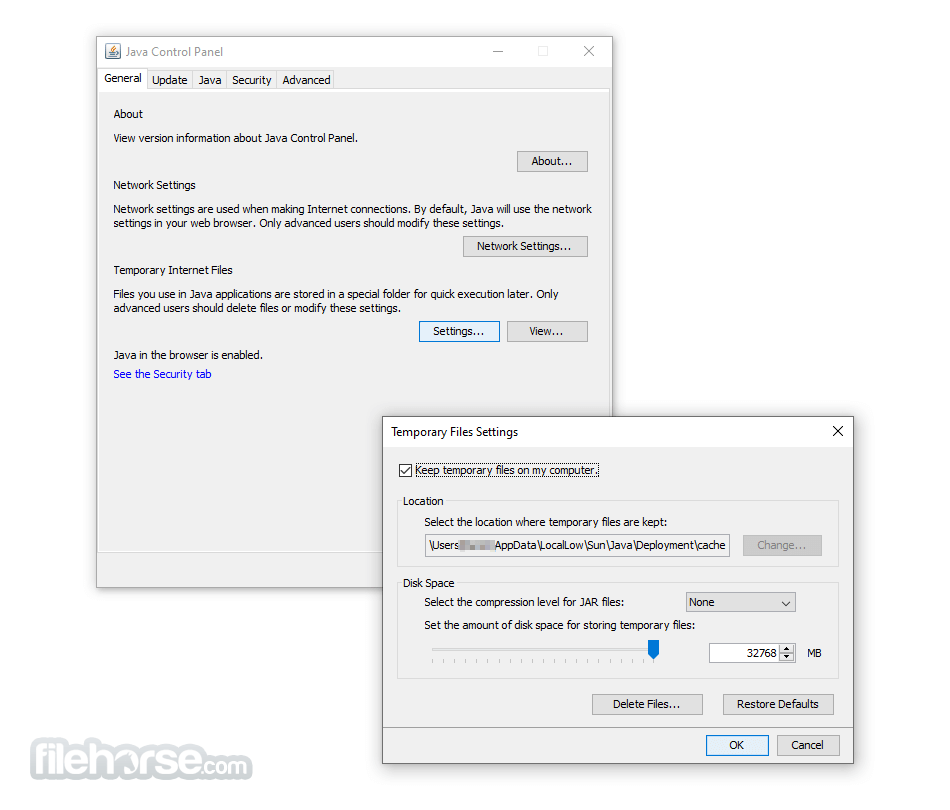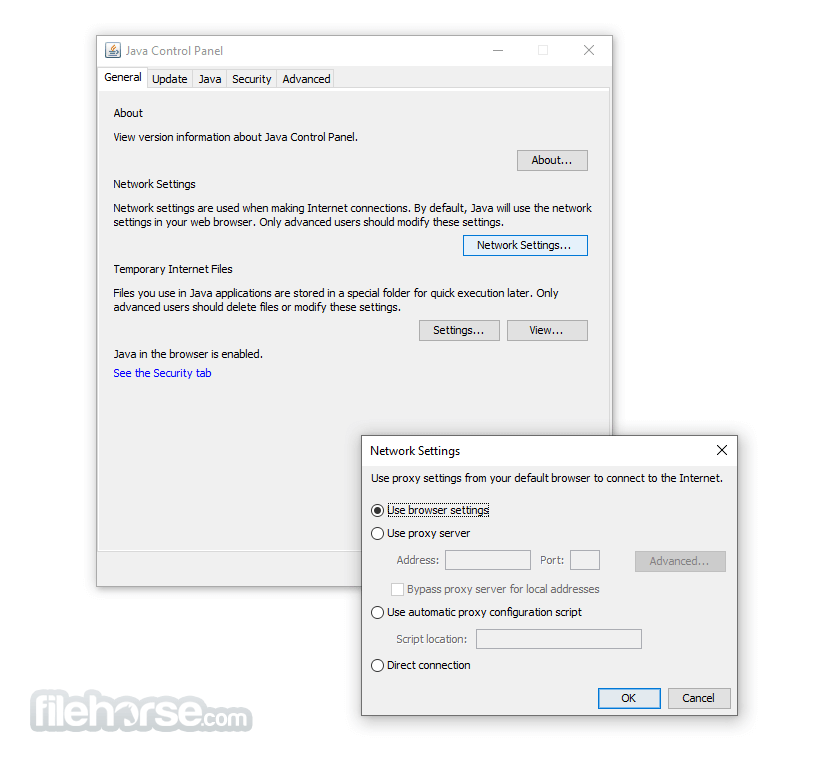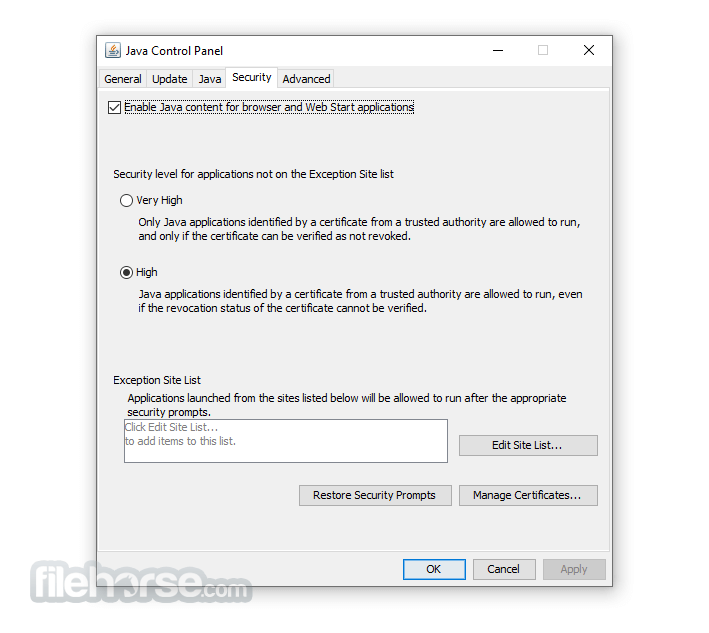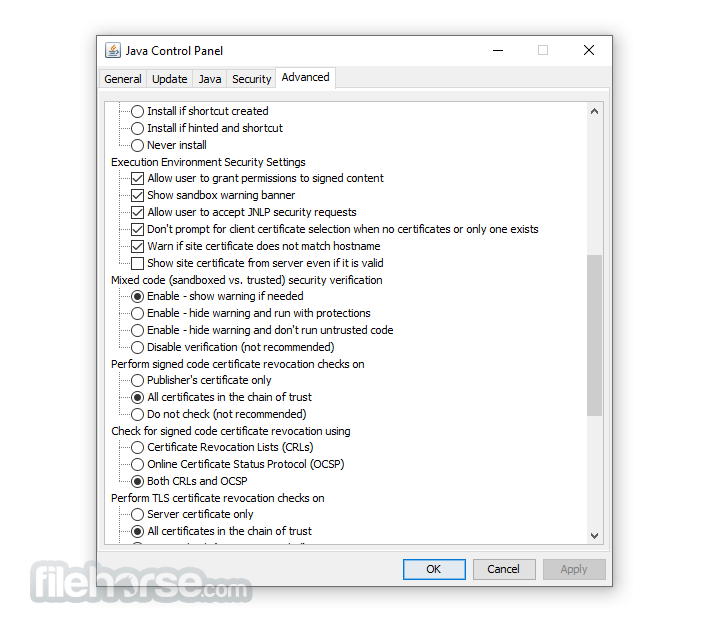-
Latest Version
Java JRE 8 Update 451 (64-bit) LATEST
-
Review by
-
Operating System
Windows 7 64 / Windows 8 64 / Windows 10 64 / Windows 11
-
User Rating
Click to vote -
Author / Product
-
Filename
jre-8u451-windows-x64.exe
-
MD5 Checksum
78ddb017979adc0d53292ac5073eeb67
It's also integral to the intranet applications and other e-business solutions that are the foundation of corporate computing.
It provides the libraries, the Java Virtual Machine, and other components to run applets and applications written in the Java programming language.
In addition, two key deployment technologies are part of the JRE: Java Plug-in, which Enables Applets to Run in Popular Browsers; and Web Start, which deploys standalone applications over a network. Many cross-platform applications also require Java to operate properly.
It is a programming language and computing platform first released by Sun Microsystems in 1995. There are lots of applications and websites that will not work unless you have Java installed, and more are created every day.
The program is fast, secure, and reliable. From laptops to data centers, game consoles to scientific supercomputers, and cell phones to the Internet, Java is everywhere! It is at the heart of the digital lifestyle. It's the platform for launching careers, exploring human-to-digital interfaces, architecting the world's best applications, and unlocking innovation everywhere—from garages to global organizations.

Main Features
- Java Virtual Machine (JVM): JRE includes a Java Virtual Machine (JVM), which is responsible for executing Java bytecode.
- Class Libraries: It includes a set of class libraries that provide a wide range of functionality for Java programs. These libraries include collections, I/O, networking, security, and many other features.
- Security: It provides a robust security model that ensures that Java programs run in a secure environment. It includes features such as sandboxing, code signing, and permission-based access control.
- Automatic Memory Management: It includes automatic memory management, which means that the JVM automatically manages the allocation and deallocation of memory for Java programs.
- Platform Independence: Java programs that run on JRE are platform-independent, which means that they can run on any platform that has JRE installed, regardless of the underlying hardware or operating system.
- Internationalization: It provides support for internationalization and localization, which allows Java programs to run in different languages and regions.
- Deployment: It provides an easy and convenient way to deploy Java programs on various platforms, such as desktops, servers, and mobile devices.
- Install JRE: First, you need to download and install the latest version of JRE from the official Java website or FileHorse.
- Write Java code: Next, write Java code using any text editor or integrated development environment (IDE) like Eclipse, NetBeans, or IntelliJ IDEA.
- Compile Java code: Once you have written your Java code, you need to compile it into byte code using the Java compiler. You can do this by running the "javac" command in the command prompt or terminal.
- Run Java program: After compiling your Java code, you can run it using the "java" command in the command prompt or terminal. This will execute the Java Virtual Machine (JVM) and load your byte code.
- Test and debug: You can test and debug your Java program using various tools provided by the IDE or through the command prompt. This will help you find and fix any errors or bugs in your code.
- Distribute Java program: Finally, once you have tested and debugged your Java program, you can distribute it to others. You can package your code into a JAR (Java Archive) file and distribute it to others who have JRE installed on their computers.
What is Java Runtime Environment (JRE)?
A: Java Runtime Environment (JRE) is a software package that provides the necessary components to run Java programs. It includes the Java Virtual Machine (JVM), libraries, and other components required to run Java applications.
What is the difference between JRE and JDK?
A: JDK (Java Development Kit) is a software development kit that includes the JRE, along with other tools like compilers and debuggers that are needed to develop Java applications. JRE is used to run Java programs, while JDK is used to develop them.
Can I run Java applications without installing JRE?
A: No, you need to install JRE in order to run Java applications.
How do I install JRE on my computer?
A: You can download and install the latest version of JRE from the official Java website. Follow the installation instructions provided on the website.
How do I check if JRE is installed on my computer?
A: You can check if JRE is installed on your computer by typing "java -version" in the command prompt or terminal. If JRE is installed, it will display the version information.
Is JRE free to use?
A: Yes, JRE is free to use for personal and commercial purposes.
Can I install multiple versions of JRE on my PC?
A: Yes, you can install multiple versions of JRE on your computer. However, it is recommended to use the latest version of JRE to ensure security and performance.
Can I uninstall older versions of JRE after installing a new version?
A: Yes, you can uninstall older versions of JRE after installing a new version. It is recommended to keep only the latest version of JRE installed on your computer.
Do I need to update JRE regularly?
A: Yes, it is recommended to update JRE regularly to ensure security and performance. Java updates usually contain bug fixes, security patches, and performance improvements.
Why should I upgrade to the latest version?
A: The latest version contains important enhancements to improve the performance, stability, and security of the applications that run on your machine. Installing this free update will ensure that your applications continue to run safely and efficiently.
What will I get when I download software?
A: The Java Runtime Environment 64-bit (JRE desktop app) is what you get when you download software. The JRE consists of the Java Virtual Machine (JVM), Java platform core classes, and supporting Java platform libraries. The JRE is the runtime portion of the software, which is all you need to run it in your Web browser.
What is Java Plug-in software?
A: The program is a component of the (JRE). The JRE allows applets written in the programming language to run inside various internet browsers. The Plug-in software is not a standalone program and cannot be installed separately.
I have heard the terms Virtual Machine and JVM. Is this software?
A: The Virtual Machine is only one aspect of software that is involved in web interaction. The Java Virtual Machine is built right into your software download and helps run Java apps.
System Requirements
- OS: Windows 7, 8, 8.1, 10, 11, Windows Server 2012, Windows Server 2016, and Windows Server 2019
- Processor: It requires a minimum of a Pentium 2 266 MHz processor, although a faster processor is recommended for optimal performance.
- Memory: It requires a minimum of 128 MB of RAM, although a larger amount of RAM is recommended for running complex Java programs.
- Disk space: It requires a minimum of 124 MB of disk space for installation, although a larger amount of disk space is recommended for running Java programs.
- Display: It requires a minimum display resolution of 800 x 600 pixels, although a higher resolution is recommended for better display quality.
- Widely Supported Language
- Platform Independence
- Robust Standard Library
- Automatic Memory Management
- Strong Community Support
- Slower Execution Speed
- Steeper Learning Curve
- Verbosity of Code
Overall, Java Runtime Environment (JRE) is a software environment that provides a runtime platform for running Java programs. It includes a Java Virtual Machine (JVM), class libraries, and other features that make it easy for developers to create and run Java applications.
JRE is a powerful and flexible platform that offers features such as platform independence, automatic memory management, security, and internationalization. This makes it an ideal choice for developing and running applications on various platforms, including desktops, servers, and mobile devices.
All in all, Java Runtime Environment (JRE) provides a reliable and robust platform for running Java applications, making it an essential tool for Java developers and users.
Note: When your installation completes, you may need to restart your browser (close all browser windows and re-open) to enable the installation.
Also Available: Java Runtime Environment (32-bit) and Java Runtime Environment for Mac
What's new in this version:
- JDK 8u451 contains IANA time zone data 2025a which contains the following changes since the previous update
- Paraguay adopts permanent -03 starting spring 2024
- Improve pre-1991 data for the Philippines
- Etc/Unknown is now reserved
New Features:
security-libs/javax.crypto:pkcs11➜ Legacy Mechanism Check in SunPKCS11 Provider Is Enhanced with Service Type (JDK-8293345):
- Native PKCS11 mechanisms which support decryption but not encryption, or signature verification but not signing, are considered legacy and are disabled by default. The legacy mechanism check in SunPKCS11 provider is enhanced with the service type. For example, prior to this fix, a mechanism supporting encryption, decryption, and verification but not signing, is considered legacy and can't be used at all. After this fix, the corresponding Cipher service using this mechanism is available since both encryption and decryption are supported. However, the corresponding Signature service is not since only verification is supported. To bypass the legacy mechanism check, set the PKCS11 provider configuration attribute "allowLegacy" to true. The default value is false. Note that it is the caller's responsibility to make sure the legacy mechanism is not used for the unsupported functionality.
- Other Notes
- javafx/other
- ➜ Removal of JavaFX from Oracle JDK 8 (JDK-8341994 (not public))
- As announced in 2020, support for JavaFX on JDK 8, the last commercially supported version of JavaFX from Oracle, ended in March 2025. JDK 8 update 451 is the first upgrade of JDK/JRE 8 without JavaFX. Oracle continues to develop and release JavaFX as stand-alone modules via the OpenJFX project for the latest versions of Java only. For more details see the Java SE Spring 2024 Roadmap Update. Please contact Oracle Sales if you have any additional needs.
security-libs/javax.net.ssl➜ Distrust TLS Server Certificates Anchored by Camerfirma Root Certificates and Issued After April 15, 2025 (JDK-8346587):
- The JDK will stop trusting TLS server certificates issued after April 15, 2025 and anchored by Camerfirma root certificates, in line with similar plans announced by Google, Mozilla, Apple, and Microsoft.
- TLS server certificates issued on or before April 15, 2025 will continue to be trusted until they expire. Certificates issued after that date, and anchored by any of the Certificate Authorities in the table below, will be rejected.
- The restrictions are enforced in the JDK implementation (the SunJSSE Provider) of the Java Secure Socket Extension (JSSE) API. A TLS session will not be negotiated if the server's certificate chain is anchored by any of the Certificate Authorities in the table below and the certificate has been issued after April 15, 2025.
An application will receive an exception with a message indicating the trust anchor is not trusted, for example:
- "TLS Server certificate issued after 2025-04-15 and anchored by a distrusted legacy
- Camerfirma root CA: CN=Chambers of Commerce Root - 2008, O=AC Camerfirma S.A.,
- SERIALNUMBER=A82743287, L=Madrid (see current address at www.camerfirma.com/address), C=EU"
- The JDK can be configured to trust these certificates again by removing "CAMERFIRMA_TLS" from the jdk.security.caDistrustPolicies security property in the java.security configuration file.
The restrictions are imposed on the following Camerfirma Root certificates included in the JDK:
- CN=Chambers of Commerce Root, OU
- CN=Chambers of Commerce Root - 2008, O=AC Camerfirma S.A., SERIALNUMBER=A82743287, L=Madrid
- CN=Global Chambersign Root - 2008, O=AC Camerfirma S.A., SERIALNUMBER=A82743287, L=Madrid
You can also use the keytool utility from the JDK to print out details of the certificate chain, as follows:
- keytool -v -list -alias <your_server_alias> -keystore <your_keystore_filename>
- If any of the certificates in the chain are issued by one of the root CAs in the table above are listed in the output you will need to update the certificate or contact the organization that manages the server.
core-svc/tools➜ JarInputStream Treats Signed JARs with Multiple Manifests As Unsigned (JDK-8337494 (not public)):
- The JarInputStream class now treats a signed JAR as unsigned if it detects a second manifest within the first two entries in the JAR file. A warning message "WARNING: Multiple MANIFEST.MF found. Treat JAR file as unsigned." is logged if the system property, -Djava.security.debug=jar, is set.
security-libs/javax.crypto:pkcs11➜ Disable CKM_TLS_KEY_AND_MAC_DERIVE Mechanism in Solaris PKCS11 Configuration File (JDK-8245618):
- On Solaris, the CKM_TLS_KEY_AND_MAC_DERIVE mechanism offered by the SunPKCS11-Solaris provider and specific to TLSv1.0, can derive incorrect key data causing TLSv1.0 communication failure. That mechanism has been disabled via the $JAVA_HOME/jre/lib/security/sunpkcs11-solaris.cfg configuration file. The JCE provider now manages these cryptographic requests.
Fixed:
- The printing result is different from the case instruction.
- [macosx] Accelerators does not spelled for JMenuItems by Voice Over
- [macos13] setFullScreenWindow() shows black screen on macOS 13 & above
- [macOS, Accessibility] VoiceOver: Incorrect announcements of JRadioButton
- [macOS, Accessibility] VoiceOver: No announcements on JRadioButtonMenuItem and JCheckBoxMenuItem
- [macos] Screen magnifier does not show the magnified text for JComboBox
- [macos] a11y : Screen magnifier does not show selected Tab
- [Accessibility,Windows,JAWS] Bug in the getKeyChar method of the AccessBridge class
- Crash in ImageIO JPEG decoding when MEM_STATS in enabled
- Java MIDI fails with a dereferenced memory error when asked to send a raw 0xF7
- new javax.swing.text.DefaultCaret().setBlinkRate(N) results in NPE
- (process) java/lang/ProcessBuilder/Basic.java uses "cp -p" which is inefficient
- ExecutorService/Invoke.java fails intermittently
- C2: Unexpected dead nodes after matching
- Add additional comments for "8062370: Various minor code improvements"
- Various minor code improvements
- Failures during class definition can lead to memory leaks in metaspace
- Make AbortVMOnException available in product builds
- Update PKCS#11 Cryptographic Token Interface to v3.1
- Update PC/SC Lite for Suse Linux to 2.3.0
- Tables in javadoc documentation missing row headers
 OperaOpera 118.0 Build 5461.41 (64-bit)
OperaOpera 118.0 Build 5461.41 (64-bit) PC RepairPC Repair Tool 2025
PC RepairPC Repair Tool 2025 PhotoshopAdobe Photoshop CC 2025 26.5.0 (64-bit)
PhotoshopAdobe Photoshop CC 2025 26.5.0 (64-bit) OKXOKX - Buy Bitcoin or Ethereum
OKXOKX - Buy Bitcoin or Ethereum iTop VPNiTop VPN 6.4.0 - Fast, Safe & Secure
iTop VPNiTop VPN 6.4.0 - Fast, Safe & Secure Premiere ProAdobe Premiere Pro CC 2025 25.2.1
Premiere ProAdobe Premiere Pro CC 2025 25.2.1 BlueStacksBlueStacks 10.42.51.1001
BlueStacksBlueStacks 10.42.51.1001 Hero WarsHero Wars - Online Action Game
Hero WarsHero Wars - Online Action Game SemrushSemrush - Keyword Research Tool
SemrushSemrush - Keyword Research Tool LockWiperiMyFone LockWiper (Android) 5.7.2
LockWiperiMyFone LockWiper (Android) 5.7.2









Comments and User Reviews